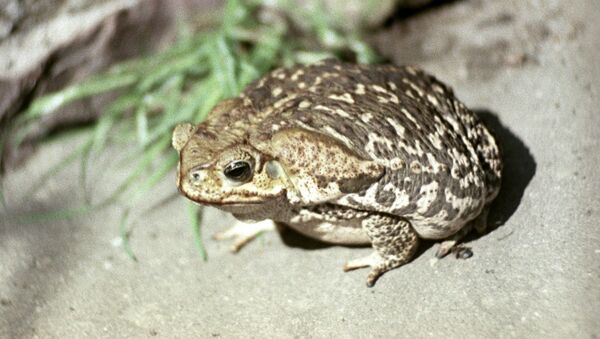Les biologistes américains de la Southwestern Research Station (SWRS) ont découvert un têtard-Goliath dans un étang au sud-est de l'Arizona, pendant qu''ils retiraient des ouaouarons américains envahissants (Lithobates catesbeianus) qui y avaient pris leurs quartiers, relate le site Live Science.
I know a lot of you were looking for updates and I can’t tell you exactly how big this guy is because the researchers haven’t published on it yet. A rough estimate would be the size of a medium banana. He is still alive and growing. His name is Goliath 😊 @swrsamnh pic.twitter.com/gWecsJwzMn
— Earyn McGee (@Afro_Herper) 14. Juni 2018
Le têtard avait alors une taille si impressionnante que les chercheurs avaient d'abord pensé qu'il s'agissait d'un poisson, a indiqué l'herpétologue Earyn McGee, doctorante à l'Université de l'Arizona et scientifique à la SWRS, sur son blog.
Elle a souligné que le «Goliath» était beaucoup plus grand que n'importe quel têtard d'un ouaouaron américain, suggérant que sa taille inhabituelle était probablement due à «une sorte de déséquilibre hormonal».
Up here at the Southwestern Research Station there is an initiative to remove invasive bull frogs from ponds. During the removal process they found a tadpole of gigantic proportions. BEHOLD #SciComm #desert #skyisland #frogs #arizona #BLACKandSTEM #womeninStem #UAResearch pic.twitter.com/e6AgaRwrhb
— Earyn McGee (@Afro_Herper) 14. Juni 2018
Or, les chercheurs du SWRS suggèrent maintenant que ce déséquilibre empêchera probablement le pauvre Goliath de se métamorphoser en grenouille, et ils étudient actuellement ce qui pourrait avoir conduit à son état inhabituel.
D'après M.McGee, le têtard continue toujours à grandir, ce qui pourrait présenter un risque majeur pour sa vie, ses systèmes respiratoires et circulatoires étant trop affectés.

